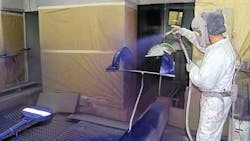Companies have until March 11 to fully comply with new standard, which may require them to buy new equipment
THE clock is ticking on paint shops everywhere.
January 9 was the deadline for companies to meet the Environmental Protection Agency's new standard known as the Hazardous Air Pollutants (HAPs) 6H rule, but the EPA is giving them until March 11 to fully comply.
The agency's main objective is to significantly lessen the amount of HAPs released into the environment during paint-stripping or surface-coating operations, during which the most dangerous chemicals — chiefly methylene chloride (MeCl), cadmium, chromium, lead, manganese, and nickel compounds — “represent significant risk to employee health if proper engineering and administrative controls are not in place.”
It will have a significant effect on trailer manufacturers and dealers that spray equipment with the most common paints, primers, and clear coats, according to Ken Eyestone, training and service manager for EXEL North America Inc, which is involved in the research, manufacturing, and distribution of equipment for painting applications.
“The hand-spray people will definitely be affected the most — and the industry, based on what I've seen, is mostly hand-spray,” Eyestone said. “A good number of companies in the industry will probably have to buy new equipment — typically an air-atomized gun with higher pressure that gives much better finish and quality.
“It's just a matter of finding the gun that makes you compliant. But the problem is that when you switch, you have to spend a lot of time finding the right combination of air cap and nozzles to work. Companies are going to have to do a lot of practice. They may have some quality issues at first. But the nice thing is that they don't have to be fully compliant until March. They have a window to figure out which combination to use before they're held accountable.”
The full regulation can be found at http://www.epa.gov/fedrgstr/EPA-AIR/2008/January/Day-09/a24718.htm
How to proceed
Jeff Brown, marketing communications specialist for EXEL North America Inc, gave these action items: locate your state air permit; locate your MSDS binders; ask yourself, “Can I test my equipment?” and “Do any exceptions apply to my shop?”; and check the efficiency of your booth filters.
“The best way to determine if a primer, base coat, or clear coat contains an HAP is to check the material safety data sheet (MSDS) binder,” Brown says. “If it is on the MSDS sheet, the 6H rule applies to you.
“To determine if your paint equipment complies, there are test air-cap gauges for HVLP compliance testing. Max air inlet pressure cannot exceed 29 psi at the gun handle in order to maintain 10 psi or less at the air cap.”
The exceptions for the 98% booth-filter-efficiency requirement:
-
If the gun has a cup capacity of no more than three ounces.
-
Powder coating.
-
Hand-held non-refillable aerosol containers.
-
Brushes, rollers, or hand wiping.
-
Flow, dip, electrode position, web, or coil.
-
Touch-up markers or marking pens.
-
Thermal spray operations using solid metallic or non-metallic materials.
-
Painting performed for facility maintenance.
Eyestone said he expects the EPA to enforce this new requirement with a greater sense of urgency than it did after the wood portion of the 6H rule was enacted five years ago.
“When they did the wood portion, I heard that the EPA didn't really go after it real hard,” he says. “My concern is that five years ago, the government wasn't really having funding issues. I'm expecting them to be more likely to enforce this because they'd be able to generate some fines. They're going to be looking for ways to fund themselves. I could be wrong. Now, with a Republican Congress, maybe they won't be. But when it was Democratic, I had all the belief that it was going to be heavily enforced. The fines can add up quickly.”
About the Author
Rick Weber
Associate Editor
Rick Weber has been an associate editor for Trailer/Body Builders since February 2000. A national award-winning sportswriter, he covered the Miami Dolphins for the Fort Myers News-Press following service with publications in California and Australia. He is a graduate of Penn State University.
